Menu
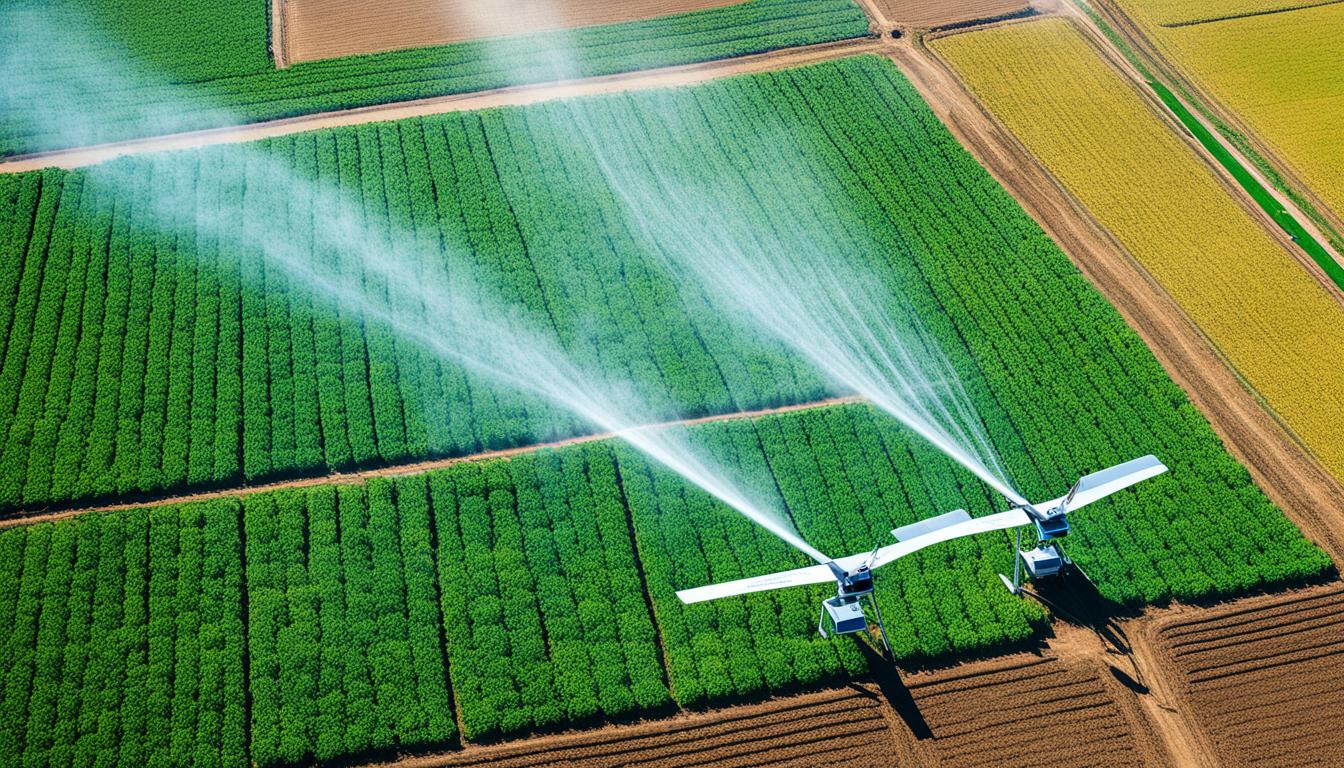
Did you know the US uses over 9 billion gallons of water each day for outdoor watering? Sadly, nearly half of this is wasted due to old, inefficient methods. Smart irrigation systems offer a new way, saving between 30% and 50% of water.
These systems use the latest tech to adjust watering. They do it based on the weather and the specific needs of your garden. By using real-time weather and plant data, these systems help save a lot of water. This supports both water conservation and the growth of crops.
Smart irrigation systems are a big step forward in smart irrigation technology. They improve the old ways of watering by using automation and settings that are just right for every garden. This helps in using water more carefully.
In places like Oklahoma, a lot of water is used outside homes. This makes up 30% to 50% of all the water used. Smart systems make sure water is used well. They avoid wasting water by giving just the right amount when the plants need it most.
Studies show how well these new systems work. In Las Vegas, for instance, they cut down watering by 20% compared to what house owners usually do. And in research on grass in St. Augustine, there was a 43% drop in water use in the summer.
Another cool thing is using sensors to control how much water the soil has. This can save a lot of water, especially during dry times. On average, this saves 34% of water in a drought. Depending on where you buy them, these sensors can cost from $280 to $1,800.
Adding rain sensors to the mix is also smart. They can pay for themselves in less than a year. For a ¼-acre garden, they can save money up to $33.95 each time it rains. This is because the system knows not to water when it’s already raining.
To wrap it up, smart irrigation is key for using water well today. It offers sustainable, efficient, and exact ways to water plants.
Smart irrigation systems fall into two groups: weather-based and soil moisture sensor-based. Both types help save water in different ways.
Weather-based systems use data like evaporation to decide when to water. They found the perfect balance for plant life in Las Vegas, saving 20% on water. For St. Augustine grass, they cut water use by 43%.
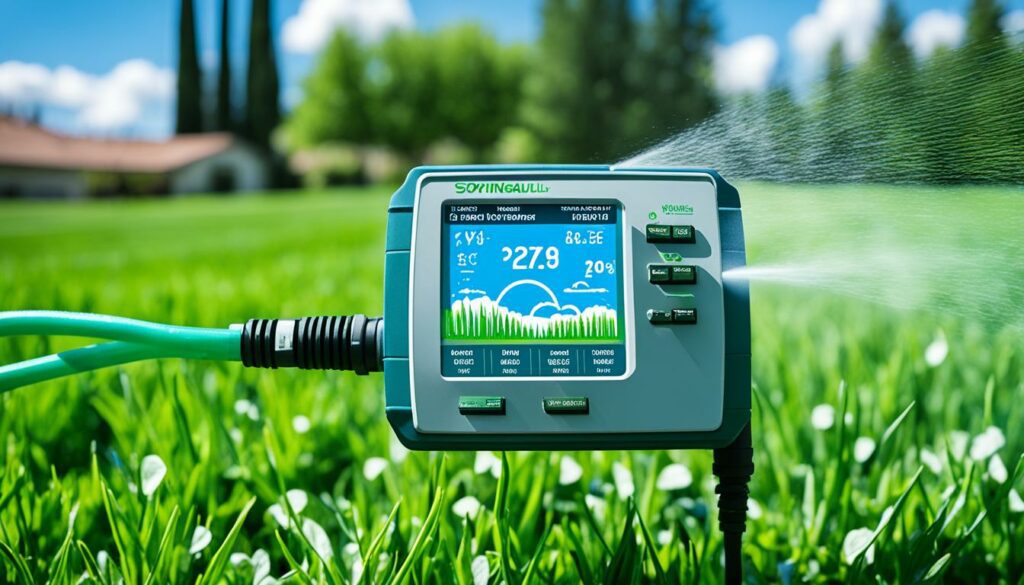
9 billion gallons of water are used daily in the US outdoors. Half of this is wasted. Weather-based systems can make a big difference. For example, in Washington, they saved more water per site compared to traditional systems.
Soil moisture systems check the soil and water only when needed. This is a great method for saving water during dry spells. They cut water use by 72% in tests, with a 34% saving overall. The systems can cost from $280 to $1,800, and sensors are priced around $99 to $165.
| Controller Type | Water Savings | Average Cost |
|---|---|---|
| Weather-Based (ET) Controllers | 20-43% | $300-$1200 |
| Soil Moisture Sensor-Based Controllers | 34-72% | $280-$1,800 |
Irrigation experts proved that smart systems could save more water than usual. This can be crucial in places like Oklahoma, where a lot of water is for the garden. With smart systems, every drop is used wisely, making homes greener.
Modern irrigation technology has changed how we farm and garden. It uses measuring tools, sensors, and data analysis. These help smart irrigation systems water plants at the right time. This saves water and keeps landscapes healthy.
Precision irrigation is vital for smart watering. By using soil moisture sensors, we can save a lot of water. For example, in the U.S., over 9 billion gallons of water are used outside daily. Up to 50% of this is wasted by old, inefficient systems.
In Las Vegas, using Evapotranspiration controllers cut water use by 20%. This saved between $250 and $900. A study on St. Augustine grass also found a 43% summer water saving. These results show how precision helps a lot.
Rain sensors are also important. They save water when it rains. Imagine saving almost $34 every time it rains at your home. That’s the benefit of using rain sensors.
“Irrigation technology, through the deployment of smart farming practices, not only ensures efficient water use but also fosters an environmentally friendly approach to irrigation, which is both economically beneficial and sustainable.”
Automated, sensor-based irrigation is a must for smart farming. Soil moisture sensors alone save 34% water in drought. Smart controllers save 30% to 50% water. Technology is key for using water wisely.
| Controller Type | Savings Percentage | Cost Range |
|---|---|---|
| Evapotranspiration Controllers | 20% – 43% | $250 – $900 |
| Soil Moisture Sensor Controllers | 34% – 72% | $280 – $1,800 |
Advanced irrigation tech saves a lot of water. This is vital because we use so much outside. It helps in smart farming, making water use efficient and good for the planet and our wallets.
Automated watering systems are a big help in managing water efficiently. They make sure plants get the exact amount of water they need. This stops overwatering and helps save water. It also saves money on water and electricity for homes, businesses, and farms.
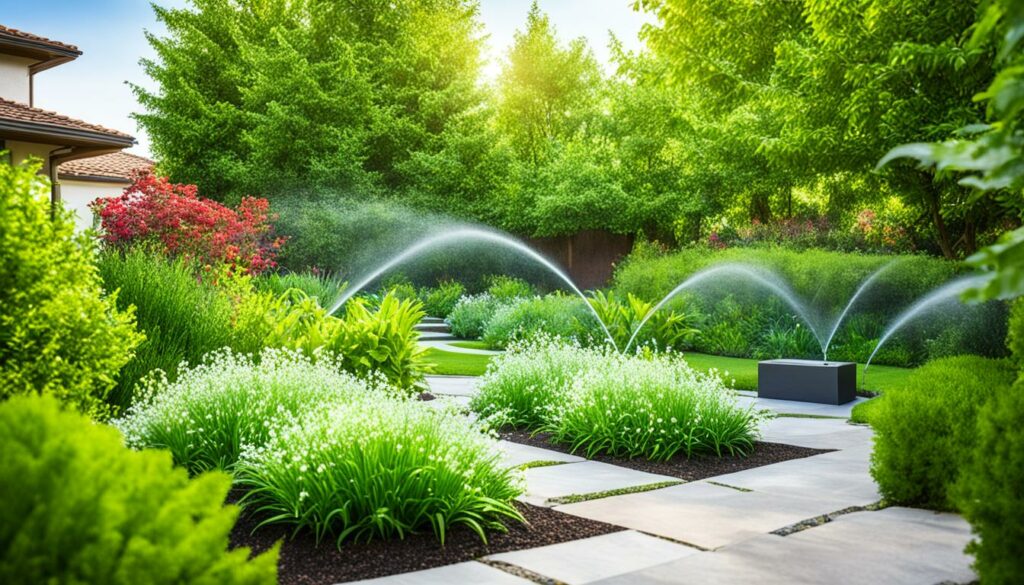
These systems bring both eco-friendly and cost-saving benefits. They keep plants healthy by watering them just right. This promotes better plant growth. For farmers, these systems save a lot of time. This means they can focus on other important work.
Using water wisely is key to these systems. They are a great fit for places with little rain. By checking the weather, they water at the best times. This means they use water well, making sure not to waste any.
Some systems can be controlled from far away. This makes managing them easy. People get alerts about their systems, keeping their gardens in top shape. These systems can also be set up to match each plant’s needs. This makes them work even better.
Using weather data is key for smart irrigation to work well. It lets these systems use up-to-the-minute weather info to save water efficiently. This is big for our environment.
ET weather data is at the heart of adjusting when to water. It looks at the temperature, wind, sun, and humidity to figure out how much water plants need. By doing this, smart systems cut down on water use by 20 to 40 percent.
Controllers that measure local weather take things to the next level. They use data from right around the system. This means they water plants just when they need it, cutting waste and saving up to 66% of water.
WaterSense labelled controllers bring these benefits home. They keep working even when the power’s out and come in lots of types, making sure everyone can use them. With these in place, up to 80% of water used for gardens goes to good use, with less than 10% wasted.
Soil moisture sensors are vital for smart irrigation. They help manage watering efficiently and precisely. These gadgets give real-time soil moisture data. This data is key in deciding if plants need water.
They are placed where plant roots are to pick up accurate moisture levels. This helps set up watering schedules automatically. Doing this helps save water and is good for the environment.
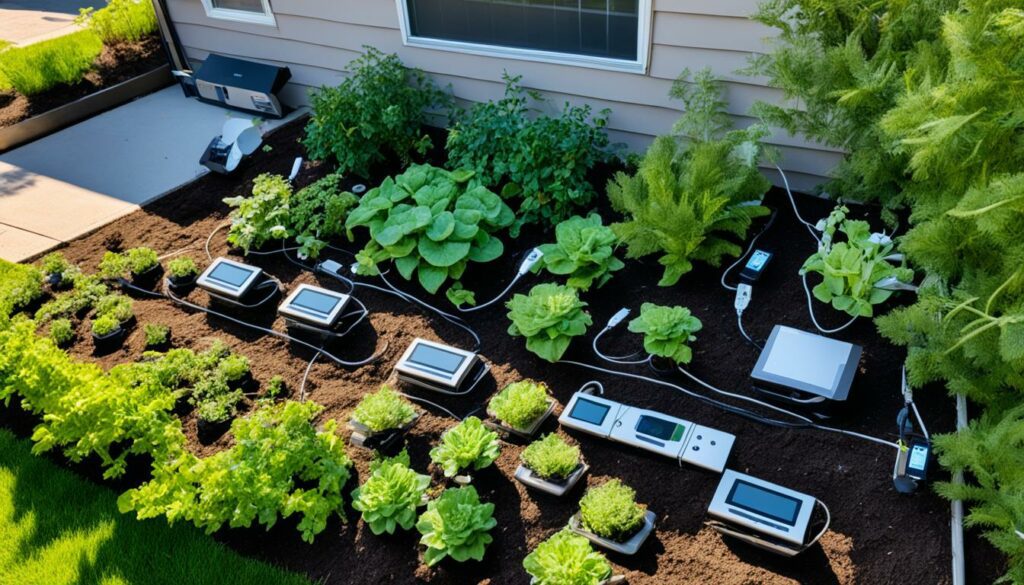
Using soil moisture sensors means water is only given to plants when they need it. This saves water and helps crops grow better and more energy efficiently. They come in different types, each with their own benefits.
Soil sensors vary in prices. For example, tensiometers are around $80, while granular sensors are $40-$50. The most expensive ones, for serious research, can cost up to $10,000. Despite the cost, using these sensors wisely can save a lot of water, especially in dry areas.
A big plus of these sensors is stopping overwatering. They adjust watering based on the soil’s real needs. This avoids problems like soil erosion. It also means plants get just the right amount of water, which is great for their growth and for the soil.
They’re also good for knowing when the soil is really ready for more water. Knowing when it’s dry can help prevent the plant from getting stressed. This prevents water being used when it’s not needed. VWC sensors are especially good at telling us just how dry the soil really is.
Making sure these sensors stay accurate over time is crucial. Their readings might change because of soil salt or just from use. It’s important to check and clean them regularly.
By using soil moisture sensors, we can save a lot of water and farm more sustainably. With water resources getting more and more precious, these sensors are essential for efficient farming and reducing water waste.
Water conservation is key for today’s irrigation systems. Technologies like automated scheduling and drip systems save water. They ensure we use water efficiently.
Older ways of watering can use too much water. This leads to waste and can harm plants. Smart technology changes this by using data and sensors. It waters plants just right, so water is not wasted.
Automated irrigation scheduling means water is used when it’s really needed. It checks things like how wet the soil is and the weather. By doing this, we cut down on water waste.
For example, smart controllers know the best times to water. This saves water and helps the plants. Another good way to water is called cycle and soak. It allows water to soak in instead of running off.
Drip irrigation technology helps a lot with saving water. It brings water straight to the roots, reducing waste. This is better than big sprinklers that often lose water to the air or ground.
Drip irrigation and special sprinkler heads make sure water is used well. They both help plants grow strong without wasting water.
Adding organic matter to soil can improve its water-holding. Combining smart tech with good soil can do even more for saving water. Smart irrigation isn’t just about not wasting water. It’s about making the most from our water.
Smart irrigation systems have changed how water is used in farming. They use technology to manage water better. This has a big effect on farm water use.
Many gallons of water are wasted each year by old, unadjusted systems. Smart technology cuts this waste a lot. It adapts watering to what the plants and the environment need, saving water.
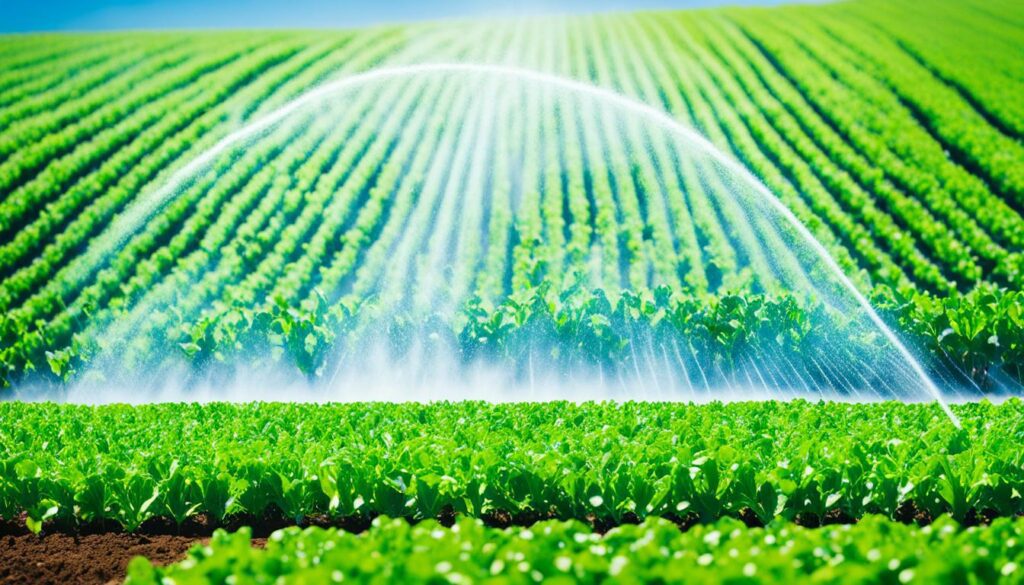
These systems save water for farmers and homeowners. They change their watering based on the day’s weather. Special sensors also check the soil to know when to water, saving a lot of water.
But smart systems help in other ways too. By not overwatering, they stop extra water polluting streams. They also save farmers money by using less energy and keeping their equipment in good shape.
They also make crops grow better. With the right amount of water, harvests can be 20-50% bigger. This improves farm income. It also helps the environment by using water more cleverly.
Finally, smart systems can fight climate change’s effects on farming. They can keep farms working well, no matter the weather. This makes farming better for the future.
Managing water in arid regions faces unique challenges, especially with limited natural water supplies. Using water wisely is crucial. Smart irrigation systems are key. They help tackle these issues.
Drip irrigation is an example. It waters plants’ roots directly. This cuts down on water loss through evaporation. It’s perfect for arid places where saving every drop is vital.
Subsurface irrigation is another method. It places water beneath the soil’s surface, so less is lost to the air. It’s good for growing crops in dry areas, despite being costly to set up at first.
To manage water well in arid areas, using the right irrigation equipment is important. Pressure-regulated and matched-precipitation sprinklers help. They make sure water is spread evenly and at the right rate. This saves water. Also, breaking up watering times with cycle and soak methods helps soil soak up more water.
Today, AgTech offers tools that give farmers instant data on soil conditions. This helps make on-the-spot, water-saving decisions. Devices from brands like Filiz and Orbit are changing the game in efficient water use.
Installing a smart controller, like the one from EPA WaterSense, can also help save water. It adjusts watering automatically, based on the weather. This means less water wasted and better plant growth.
Looking at soil health is also crucial. A small amount of organic matter in soil can hold more water for plants. This shows how working on soil quality is a big part of saving water.
| Method | Efficiency |
|---|---|
| Drip Irrigation | Highly Efficient |
| Subsurface Irrigation | Reduces Evaporation |
| Surface Irrigation | Least Efficient |
With these advanced approaches, using water well in dry places is possible. This supports farming that protects the land and keeps it productive, even in tough climates.
Knowing the financial plus points of smart irrigation is vital. The setup costs may appear high at the start. Yet, the promise of saving money over time is clear, making them a smart choice.
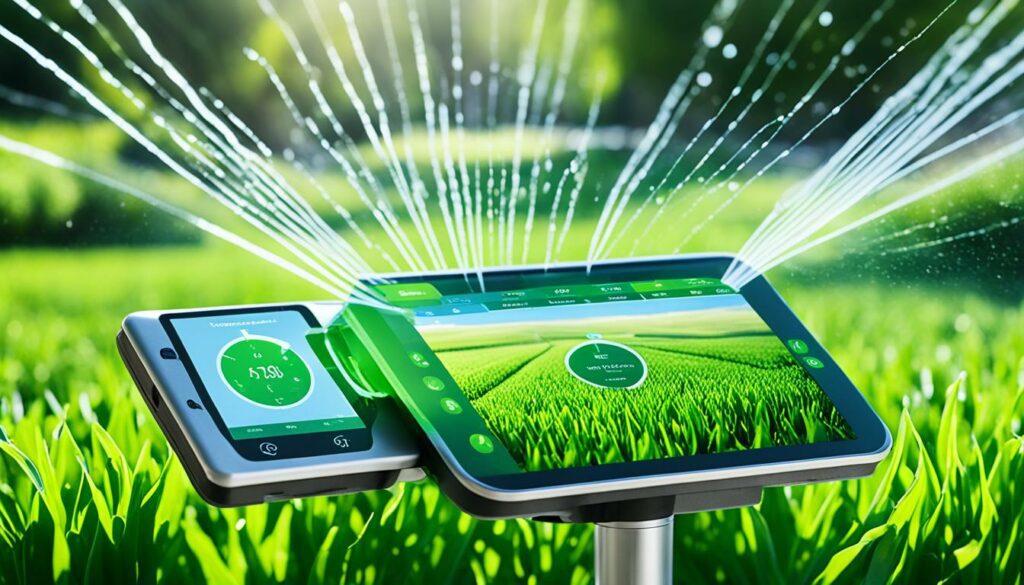
Smart irrigation systems cut water waste by a lot. They can reduce water use by half, cutting your bills. For example, WiseConn‘s devices lower water bills by 40% on average.
Smart systems also lower the costs of upkeep and replacing plants. By adjusting to real-time conditions, these systems avoid overwatering. This can cut plant loss by 70% and reduce water waste from leaks by 90%.
These savings aren’t just about water. Efficient water use can also slash energy costs by 30%. Users of WiseConn systems report saving up to 25% on power or fuel for irrigation.
From the upfront cost to the long-term savings, smart systems are a good deal. They pay for themselves in a few years with the savings they bring. They not only save money but also help the environment.
| Advantages | Smart Irrigation Systems |
|---|---|
| Reduction in Water Usage | Up to 50% |
| Reduction in Water Bills | Average 40% |
| Energy Cost Reduction | Approximately 30% |
| Reduction in Plant Loss | Up to 70% |
| Prevention of Water Wastage | Up to 90% |
| Electricity/Fuel Savings | Up to 25% |
In the end, smart irrigation is about saving money in various ways. The initial investment leads to major savings over time in water and energy expenses. It also reduces maintenance costs, making it a smart and eco-friendly option for irrigation.
The Internet of Things (IoT) has changed how we do smart irrigation. It makes the systems work much better. These smart systems can use up to 60% less water than before. This is important for saving water and managing it well.
With IoT, we can now water our plants at the best times. This helps plants grow better, sometimes up to 50% more. The technology also lets us change how much water plants get right away, based on the weather or other conditions. This can lower water waste by 90%.
Farmers and people at home can save a lot of money thanks to IoT irrigation. Farmers can save a lot on water bills every year. Homes might see their water bills drop by up to 30%. Using IoT can also lessen how much work farmers need to do. This cuts down on costs too, making these systems a good investment.
IoT also helps the environment a great deal. It lets us water plants more accurately. This means plants can be healthier by up to 70%. And it also saves water, keeping our environment better for wildlife.
The future of farming is with IoT. It’s expected that by 2023, the IoT farming market will be worth $30 billion. This shows how IoT is changing farming for the better. It helps with money, the environment, and makes farming smarter.
Exploring the benefits of smart irrigation can show us its value. It’s clear in real-life examples how saving water makes a big difference. Systems for both homes and farms have shown they are worth using more widely.
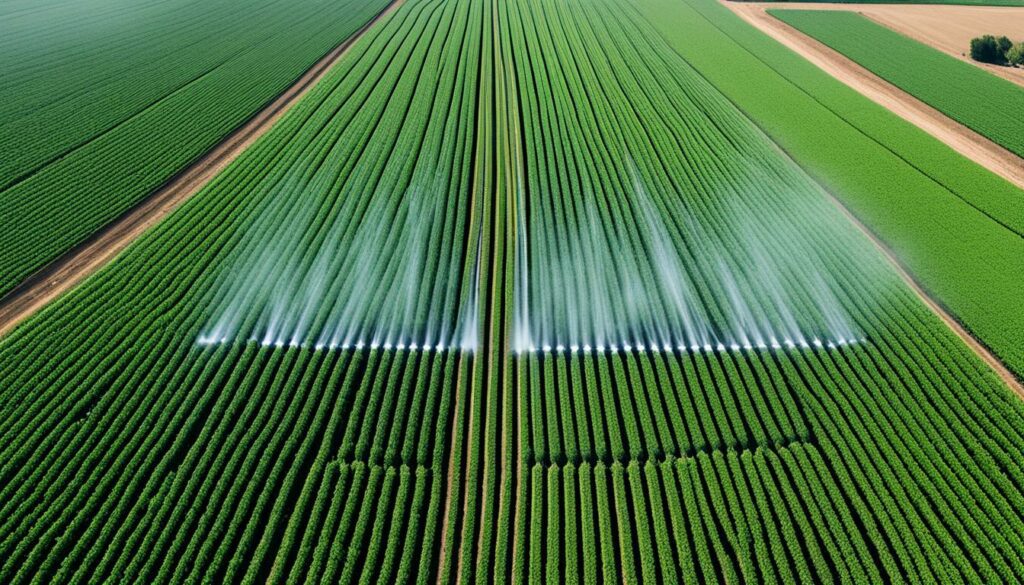
A smart irrigation study showed great results in people’s gardens. By using a soil moisture system from MAIT Industries, homeowners kept their lawns healthy. They saved a lot of water and money as well.
The study points out the good sides of these systems at homes. They are easy to install and offer quick water management improvements. With smart monitoring, people can adjust their watering precisely. This saved them a lot of money on water after just one year.
Smart systems are also a big help in large farming areas. For example, in Ipswich’s sports fields, an advanced system saved lots of money over six months. This system used real-time data to decide when and how much to water, cutting costs by a lot.
These advances are worldwide, even reaching places like India, a huge farming country. In India, smart systems are helping farmers get more crops with less water. These efforts are vital for better farming and protecting the environment.
With their success in homes and big farms, smart irrigation is doing well. It shows how important it is to save water and farm smarter. As these systems get better and easier to use, their positive impact will keep growing.
When picking a smart irrigation system, consider many factors that affect its performance. This includes local climate, soil, the plants you have, and what your land needs. By knowing these, you can pick the best watering system for your needs.
Your area’s climate is key. Places with little rain can use rain sensors. These stop sprinklers when it’s already wet, so water isn’t wasted. Dry areas might need systems that check the soil moisture. This stops watering when the plants don’t need it, saving water.
The type of plants and soil you have matters too. Drip systems are great for varied plant types. They focus water right at the plant’s roots, using less and stopping weed growth. But for big grassy areas, like lawns, sprinklers work better because they cover more space.
Think about how easy it is to add to your irrigation system. People who might change their gardens later should choose systems that can grow with them. Also, using pressure regulators and flow sensors improves how your system works. They keep water pressure steady and stop waste caused by too much pressure.
| System Type | Ideal Use | Considerations |
|---|---|---|
| Drip Irrigation | Individual plants, small areas | Reduces water wastage, minimises weed growth |
| Sprinkler Systems | Lawns, large gardens | Wide coverage, suited for lawns |
| Micro-Spray Systems | Flower beds, potted plants | Perfect for small to medium-sized areas |
| Soaker Hoses | Garden beds | Deep root penetration, efficient watering |
| Micro Sprinklers | Container gardens, narrow planting areas | Gentle, even coverage |
Getting advice from a professional can also help. They know how to match the system with your garden’s specific needs, saving you time and money. Planning and setting up the system correctly is key. With the right advice, you can get a system that’s perfect for your space.
Smart irrigation systems are changing how we manage water. Using technology makes saving water easier. The EPA says these systems can cut outdoor water use by up to 30%. This saves water and money, especially in hot summers.
These systems do more than save water. They cut down on bills for homeowners. Cities may even pay people to use this tech. Companies like Conserva Irrigation of Richmond help keep lawns green with less water. You could save up to 60% on your water use. Installation is easy, and you get great warranties.
Smart irrigation is also helping farms. For example, drip irrigation uses less water and boosts crops. It’s making farming greener and more profitable. Countries around the world are working on better ways to save water. There’s a lot of new tech coming, showing this field is growing fast.
Using smart irrigation is a big step towards saving water and farming sustainably. It uses IoT sensors and weather data to manage water well. This tech will play a key part in our water-saving efforts. For a greener future, smart irrigation is a must.
Smart irrigation systems use high-tech to control water use in gardens and farms. They adjust watering based on immediate weather, soil, and plant needs.
They save water by using advanced methods. These include checking the weather and soil first, then only watering as much as necessary. They also use drip watering techniques to prevent waste.
Weather-based controllers look at local weather to manage watering. They consider how fast water evaporates from plants and soil. Soil moisture sensor-based controllers focus on how wet the soil is. They adjust watering based on the moisture levels in the ground.
They look at local weather, including temperature and how windy it is. This helps them work out exactly how much water plants need. Smart systems can also use on-the-spot weather info for extremely accurate adjustments.
Soil moisture sensors track soil wetness and tell the system when to water. This way, plants get just the right amount of water, reducing waste.
It’s vital for saving water in farming. Smart systems give plants just what they need. This cuts down on water use, making farming more efficient and earth-friendly.
Absolutely, it’s a big help in dry areas with not much water. These systems water precisely, keeping fields and gardens growing without wasting any drops.
Smart systems might cost more at the start, but they save money long-term. They lower water and upkeep bills. Plus, they keep plants healthy, so you don’t need to replace them often.
IoT makes these systems smarter by connecting them to the web. This boosts their performance and eco-friendliness by handling data better and in real-time.
Yes, many places like homes, companies, and farms are using these systems well. They’ve shown they can manage water with care in different locations and conditions.
Choose based on where you live, the local climate, your soil, and what plants you grow. Knowing these details and looking at the tech features will help pick the best option.